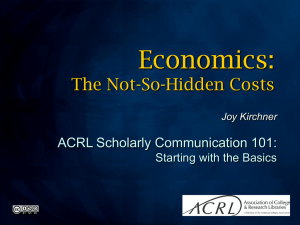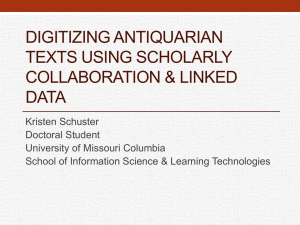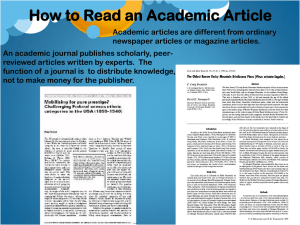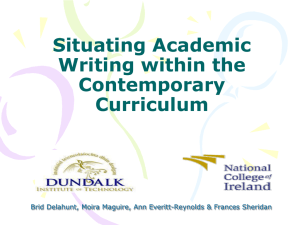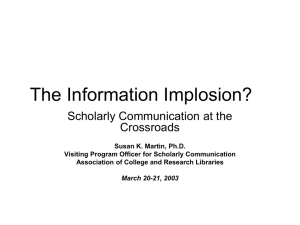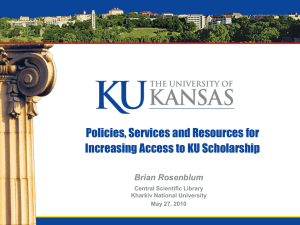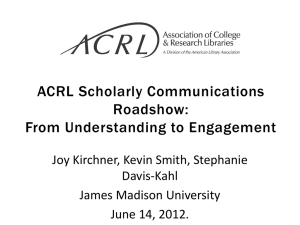Introduction to Scholarly Publishing
advertisement
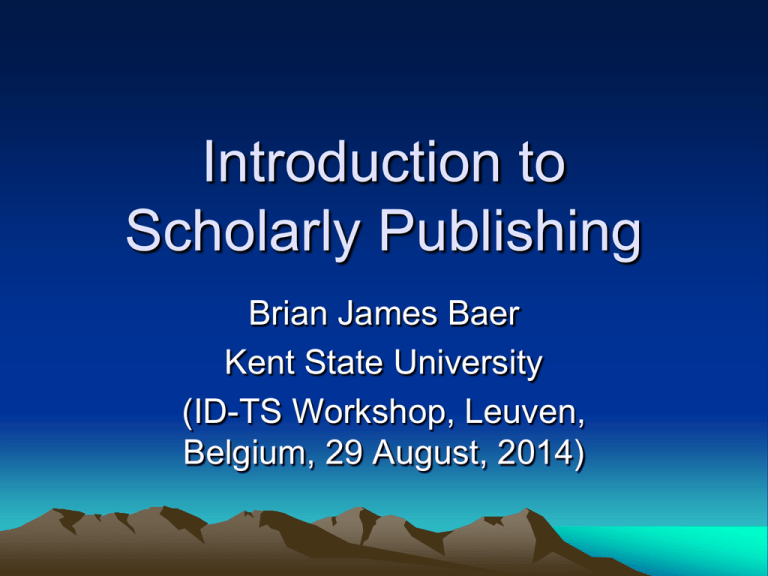
Introduction to Scholarly Publishing Brian James Baer Kent State University (ID-TS Workshop, Leuven, Belgium, 29 August, 2014) Scholarly Publishing • Part I: De-mystifying Scholarly Publishing • Part II: The Ethics of Scholarly Publishing Scholarly Publishing • Why to talk to doctoral students about scholarly publishing? • When to talk to doctoral students about scholarly publishing? • What to say to doctoral students about scholarly publishing? • How to talk to doctoral students about scholarly publishing (modalities)? Scholarly Publishing: Why? • Enhances employment opportunities • Allows students to take advantage of the support of experienced authors and editors, as well as peers (writing groups) • Provides opportunities for constructive expert feedback Scholarly Publishing: Why? • Increasing pressure to decrease the time to degree • Increasing pressure to quantify scholarly output • Increasing pressure to close the gap between classroom performance and realworld proficiency Scholarly Publishing: Why? Broughton and Conlogue (2001) found in their survey of search committees that: “evidence of teaching ability outranks evidence of research ability” Scholarly Publishing: When? • Some argue that early publication and conference presentation keep students from "developing long-term intellectual projects and thus propagates intellectual shallowness” (Guillory 4; see Spacks) Scholarly Publishing: When? • Excessive pressure to publish or attempts to publish too early can have disastrous results: –Writer’s block –Unethical practices Scholarly Publishing: When? • Others contend that there is nothing wrong with such activities as long as they do not result in “inferior professionalization” (Nelson 162). Scholarly Publishing: What to Say? • Explicit discussion of scholarly publishing should be one aspect of an overall intrusive advising approach Scholarly Publishing: What to Say? • Scholarly publishing should be discussed together with other scholarly activities that serve to transition students into the professional world of academia Setting Professional Goals • The goals should be reasonable and achievable • Goals should not interfere with the timely completion of the degree • Goals should spiral up Setting Professional Goals • Memberships in regional, national and international scholarly organizations (listservs, newsletters, journal subscriptions) Setting Professional Goals • Presentations at regional, national and international scholarly conferences Setting Professional Goals • Publication of an article in a peer-reviewed scholarly venue (listservs, journal subscriptions, newletters) – Co-authored with advisor – Single-authored Setting Professional Goals • Spiral up (levels of scholarly feedback) – Departmental presentation – Conference presentation (reviewed abstracts) – Publication in a peer-reviewed venue De-mystifying Scholarly Publishing • Journal Editors • Think of publishing as inserting yourself into an ongoing conversation Publishing as Conversation • Grice’s Maxims: – Maxim of Quality: Be truthful – Maxim of Quantity: Be as informative as required – Maxim of Relation: Be relevant – Maxim of Manner: Be clear Publishing Tips • CLARITY • CLARITY • CLARITY Types of Review • Peer review • Blind (anonymous) • Single/Double • Editorial review (invited) Assessment • Accept as is • Accept with minor revisions • Accept with major revisions/Revise and resubmit • Reject Assessment • Students may need help deciphering the decision, especially “Revise and Resubmit” • Students may need help deciding whether to revise a rejected manuscript before sending to another venue Finding a Home • Matching a manuscript with the proper venue Finding a Home “When thinking about the best format in which to publish, authors should consider the wide range of available options and their implications in terms of medium, audience, accessibility, permanence, and peer review” (MLA website, Advice for Authors, Reviewers, Publishers, and Editors of Literary Scholarship, accessed 8/20/14) Finding a Home • General topic journals in TS: – Babel – Linguistica Antverpiensia – Meta – Target – The Translator – Translation and Interpreting Studies – Translation Studies – TTR Finding a Home • Special issues of journals • Specialized journals – Translator and Interpreter Trainer – Interpreting – mTm (online) – Translation Spaces (online) • New journals (indexed?) Finding a Home • Mission of journal or organization • Submission guidelines (length, style guide) • Quality/nature of review (feedback): Posted rubrics? Additional feedback for new scholars? • Length of review process/publication timeline Asking Questions DON’T BE AFRAID TO ASK QUESTIONS!!! Finding a Home Impact Factor •Created by Eugene Garfield, founder of the Institute for Scientific Information •Designed to measure the importance or impact of a scholarly journal Impact Factor Used my many organizations (universities, granting agencies) to quantify the impact of a journal and, by extension, the importance or relevance of a scholar’s work Impact Factor • Calculated yearly starting from 1975 for journals indexed in the Journal Citation Reports • The average number of citations received per paper published in that journal during the two preceding years • Journals indexed starting with a volume other than volume one will not get an IF until they have been indexed for 3 years Impact Factor Calculated by dividing: • The number of times all items published in a given journal during the previous two years were cited by indexed publications during a given year • By the total number of "citable items" published by that journal in that two year period Impact Factor • "Citable items" include articles, reviews, proceedings, and notes, but not editorials or letters to the editor • Objections to the use of Impact Factor is assessing an author’s scholarly output Impact Factor • It is easily manipulated by certain editorial policies • One hugely popular work can skew the reading for a given period • 90% of Nature’s 2004 IF was based on only 40% of its citable items • Fluctuates significantly across disciplines, based on the speed with which papers get cited in a field Impact Factor • Journal rankings constructed based solely on impact factors only moderately correlate with those compiled from the results of expert surveys • Many departments in the US will determine which journals are considered the leading ones in a given field, ignoring IF rankings Citation Index • Alternative metrics that include article views, downloads, and/or mentions in social media (i.e., tweets) • Article-level metrics • Author-based metrics (total citations or average citation count per article): h-index, g-index Citation Index Citations determined using: • Subsciption-based databases: Scopus and Web of Knowledge • Open databases: Google Scholar • Strengths and Weaknesses of the databases Citation Indexes Designed for the hard sciences, in which: • Journals are the preferred form for the dissemination of research • Most publications are co-authored by members of a research team • Authors may publish several articles in a given year based on the same study / data set Other Venues • Collected volumes • Conference proceedings • Professional publications (ATA Chronicle) • Encyclopedias Evaluating Other Venues • Nature/quality of review process • Review/publication timeline • Has a publisher committed to the project (contract)? • Publisher/Editor/Series information Where to Begin? • Acquaint yourself with the journals, book series, publishers in the field of TS • Examine current calls for papers (conferences, collected volumes): Identify hot topics / key concepts • Don’t think final paper—think future publication!!! How to Discuss Scholarly Publishing • Discussion of scholarly publishing can take place in one of the following modalities, or in a combination thereof: – Make online materials available to students to consult on their own time – Disseminate information through a mentoring system (Remember: mentors need training!) – Hold face-to-face workshops with students Part II: Ethics of Scholarly Publishing • Plagiarism • Avoid multiple submissions • Acknowledgements: Citation is free!!! Defining Plagiarism "Plagiarize" means to take and present as one's own a material portion of the ideas or words of another or to present as one's own an idea or work derived from an existing source without full and proper credit to the source of the ideas, words, or works. As defined, plagiarize includes, but is not limited to: Defining Plagiarism (a) The copying of words, sentences and paragraphs directly from the work of another without proper credit; Defining Plagiarism (b) The copying of illustrations, figures, photographs, drawings, models, or other visual and nonverbal materials, including recordings, of another without proper credit; and Defining Plagiarism (c)The presentation of work prepared by another in final or draft form as one's own without citing the source, such as the use of purchased research papers. (Taken from the Kent State University Policy on Plagiarism) Causes of Plagiarism – Pressure to publish / time pressures – Lack of understanding as to what constitutes plagiarism – Different concepts of textual ownership – Ease of plagiarism with the availability of online material that can be cut and pasted Plagiarism • How does your university deal with plagiarism? Detecting Plagiarism While new technologies have made it easier to plagiarize, they have also made it easier to detect plagiarism Detecting Plagiarism • Programs, such as SafeAssign and TurnItIn, that are a part of your university’s learning management system • Programs, such as Grammarly and PaperRater, that individuals can purchase but that are less robust than the university systems Detecting Plagiarism Detecting Plagiarism Plagiarism School In an effort to try to make a difficult situation involving student behavior into a valuable educational experience, Kent State University developed "Plagiarism School." Plagiarism School When an instructor determines that an act of plagiarism was more the result of poor preparation for college or inadequate writing skills and less the result of out-right academic dishonesty, he or she can ask a student accused of plagiarism to attend Plagiarism School. Plagiarism School Plagiarism School is a one-on-one session lasting about 45 minutes (a fuller description is included below). While serving as a means to reeducate and rehabilitate students who plagiarize, students can also mitigate the sanction applied by the instructor. Plagiarism School For example, instead of failing the assignment the student may be offered the opportunity to resubmit the corrected assignment (perhaps for a reduced grade) in return for completing Plagiarism School. Plagiarism School In addition to diminishing the negative results of being accused of plagiarism, attending plagiarism school leaves students feeling that they are better equipped to understand and avoid plagiarism in the future, turning a potentially devastating situation into a more positive one. (www.kent.edu) Summary • Discuss scholarly publishing as part of an overall approach to intrusive advising • De-mystify scholarly publishing for your students • Encourage students to review the mission statements of journals and to ask questions regarding the level of review and the length of review • Make sure students are aware of the ethical issues involved The End Happy publishing!
